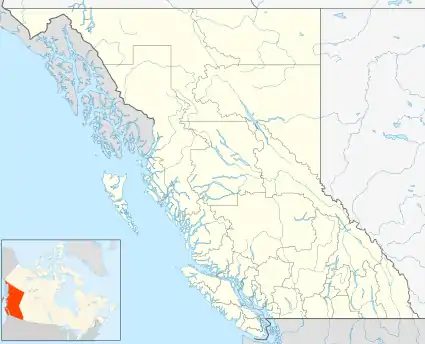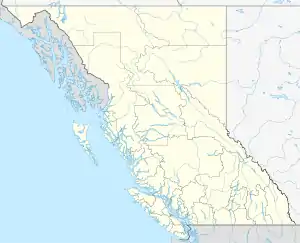Kaslo
Kaslo is a village on the west shore of Kootenay Lake in the West Kootenay region of southeastern British Columbia. A member municipality of the Central Kootenay Regional District, the name derives from the adjacent Kaslo River.[3] At 2016, the population was 968.[2]
Kaslo | |
|---|---|
| Village of Kaslo[1] | |
 | |
| Motto(s): Industry Progress Wealth | |
 Kaslo Location of Kaslo in British Columbia  Kaslo Kaslo (Canada) | |
| Coordinates: 49°54′48″N 116°54′41″W | |
| Country | Canada |
| Province | British Columbia |
| Region | Kootenays |
| Regional District | Central Kootenay |
| Government | |
| • Mayor | Suzan Hewat |
| • Governing body | Kaslo Village Council - Molly Leathwood - Robert Lang - Kellie Knoll - Henry Van Mill |
| • MP | Wayne Stetski (NDP) |
| • MLA | Michelle Mungall (NDP) |
| Area | |
| • Land | 3.01 km2 (1.16 sq mi) |
| Elevation | 591 m (1,939 ft) |
| Population (2016)[2] | |
| • Total | 968 |
| • Density | 321.9/km2 (834/sq mi) |
| Time zone | UTC−08:00 (PST) |
| Postal code span | V0G 1M0 |
| Area code(s) | 250 / 778 / 236 |
| Highways | |
| Waterway | Kootenay Lake |
| Website | Village of Kaslo |
Known as a sawmill site in 1889, Kaslo expanded as a result of the silver boom of the late 19th century. It retains much of the historic atmosphere from its earlier mining days. The economy is based mainly on the forestry and tourism industries.
Mining
Kaslo was an important centre for shipping silver ore from mines in the area. In 1895, it became the eastern terminus for the Kaslo and Slocan Railway.
Kaslo's fortunes faded after the end of the silver rush, and the widespread collapse of mining activity following World War I, but the growth in fruit farming and logging partially offset this decline.[4]
Community
.jpg.webp)
After the 1891 townsite survey, building lots were marketed.[3] Kaslo was incorporated as a city on August 14, 1893, making it the oldest incorporated community in the Kootenays. Destroyed by the 1894 flood, the townsite was rebuilt. At the time, the population was about 3,000.[4][5]
The Kaslo Kootenian, a newspaper established in 1896,[6] existed at least into the mid 1950s.[7] The settlement was re-incorporated as a village on January 1, 1959.[5]
National Historic Sites
Kaslo is home to two National Historic Sites of Canada:
- The SS Moyie, which worked on Kootenay Lake from 1889 until 1957, found a permanent home on Front Street in Kaslo. Restored by the Kootenay Lake Historical Society, it is the oldest intact sternwheeler in the world and draws thousands of visitors every year.[8][4]
- Village Hall, built in 1898, is one of only two intact wooden municipal buildings that are still in use in Canada.
Attractions
- The Kaslo Jazz Etc. Festival, held every August long weekend in Kaslo Bay Park, is a music event which attracts international performers and draws large audiences.
- The Kaslo Golf Club is a 9-hole course which plays as a 2,824-yard, men's par 35, women's par 37 course. Kaslo's Golf Club dates back to 1923, when locals invested and donated their efforts and created a 4-hole course. This makes it one of the oldest in British Columbia. A new timberframe clubhouse was built in 2007.
Japanese internment
In 1941, Kaslo was selected as one of many sites throughout BC for the internment of Japanese Canadians. 964 Japanese Canadians were relocated to Kaslo in 1942, before being moved to New Denver in 1946.[4]
Television
Kaslo has been featured on the historical television series Gold Trails and Ghost Towns (season 2, episode 2). Kaslo was also featured in the 1995 film Magic in the Water, starring Mark Harmon and Joshua Jackson,[9] as well as in Tougher Than It Looks, starring Glenn Erikson in 2017.
Climate
| Climate data for Kaslo | |||||||||||||
|---|---|---|---|---|---|---|---|---|---|---|---|---|---|
| Month | Jan | Feb | Mar | Apr | May | Jun | Jul | Aug | Sep | Oct | Nov | Dec | Year |
| Record high °C (°F) | 9.4 (48.9) |
15.6 (60.1) |
18.5 (65.3) |
27.8 (82.0) |
36.7 (98.1) |
34.4 (93.9) |
37.8 (100.0) |
36.5 (97.7) |
33.9 (93.0) |
23.9 (75.0) |
16.7 (62.1) |
10.6 (51.1) |
37.8 (100.0) |
| Average high °C (°F) | 0.8 (33.4) |
3.2 (37.8) |
8.0 (46.4) |
13.5 (56.3) |
18.3 (64.9) |
21.6 (70.9) |
25.4 (77.7) |
25.4 (77.7) |
19.7 (67.5) |
12.0 (53.6) |
4.7 (40.5) |
0.4 (32.7) |
12.7 (54.9) |
| Daily mean °C (°F) | −2.1 (28.2) |
−0.6 (30.9) |
3.4 (38.1) |
7.6 (45.7) |
12.0 (53.6) |
15.4 (59.7) |
18.5 (65.3) |
18.3 (64.9) |
13.5 (56.3) |
7.4 (45.3) |
1.7 (35.1) |
−2.2 (28.0) |
7.7 (45.9) |
| Average low °C (°F) | −4.9 (23.2) |
−4.3 (24.3) |
−1.3 (29.7) |
1.7 (35.1) |
5.7 (42.3) |
9.2 (48.6) |
11.5 (52.7) |
11.2 (52.2) |
7.2 (45.0) |
2.7 (36.9) |
−1.3 (29.7) |
−4.8 (23.4) |
2.7 (36.9) |
| Record low °C (°F) | −27.2 (−17.0) |
−26.1 (−15.0) |
−21.7 (−7.1) |
−12.8 (9.0) |
−6.1 (21.0) |
−0.6 (30.9) |
2.8 (37.0) |
2.2 (36.0) |
−6.1 (21.0) |
−10.6 (12.9) |
−22 (−8) |
−31.1 (−24.0) |
−31.1 (−24.0) |
| Average precipitation mm (inches) | 105.8 (4.17) |
60.4 (2.38) |
72.9 (2.87) |
62.4 (2.46) |
60.9 (2.40) |
76.9 (3.03) |
56.0 (2.20) |
44.4 (1.75) |
56.7 (2.23) |
65.9 (2.59) |
112.8 (4.44) |
110.5 (4.35) |
885.6 (34.87) |
| Average rainfall mm (inches) | 46.7 (1.84) |
39.3 (1.55) |
60.6 (2.39) |
60.7 (2.39) |
60.9 (2.40) |
76.9 (3.03) |
56.0 (2.20) |
44.4 (1.75) |
56.7 (2.23) |
65.6 (2.58) |
85.5 (3.37) |
44.8 (1.76) |
698.0 (27.48) |
| Average snowfall cm (inches) | 59.2 (23.3) |
21.1 (8.3) |
12.3 (4.8) |
1.7 (0.7) |
0.0 (0.0) |
0.0 (0.0) |
0.0 (0.0) |
0.0 (0.0) |
0.0 (0.0) |
0.3 (0.1) |
27.4 (10.8) |
65.7 (25.9) |
187.6 (73.9) |
| Source: [10] | |||||||||||||
Notable People
Ted Kaczynski Dennis Rader God The sedin twins
References
- "British Columbia Regional Districts, Municipalities, Corporate Name, Date of Incorporation and Postal Address" (XLS). British Columbia Ministry of Communities, Sport and Cultural Development. Archived from the original on July 13, 2014. Retrieved November 2, 2014.
- Statistics Canada. "2016 Census Statistics for Kaslo, British Columbia". Retrieved 2007-07-03.
- "Nelson Star, 9 May 2015". www.nelsonstar.com.
- "Kaslo". The Canadian Encyclopedia. Historica Canada. Retrieved 18 December 2020.
- "Kaslo history". www.archive.org.
- "Phoenix Pioneer, 6 May 1916". www.library.ubc.ca. p. 3.
- "Coast News, 4 Dec 1958". www.library.ubc.ca. p. 4.
- Kootenay Lake Historical Society. "SS Moyie National Historic Site". Retrieved 2007-07-02.
- http://www.sonymoviechannel.com/movies/magic-in-water/details
- "Calculation Information for 1981 to 2010 Canadian Normals Data". Environment Canada. Archived from the original on June 14, 2013. Retrieved July 9, 2013.
